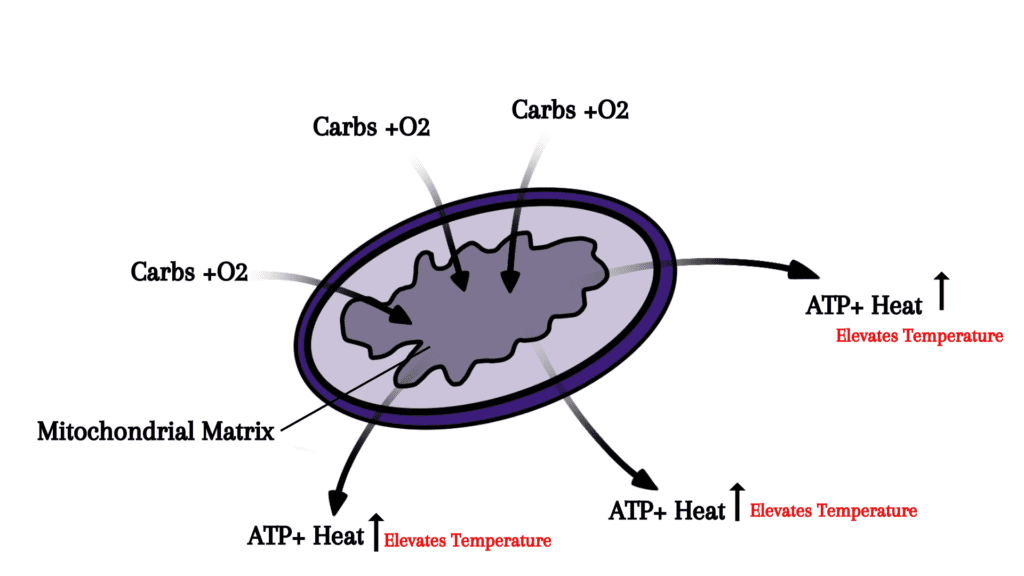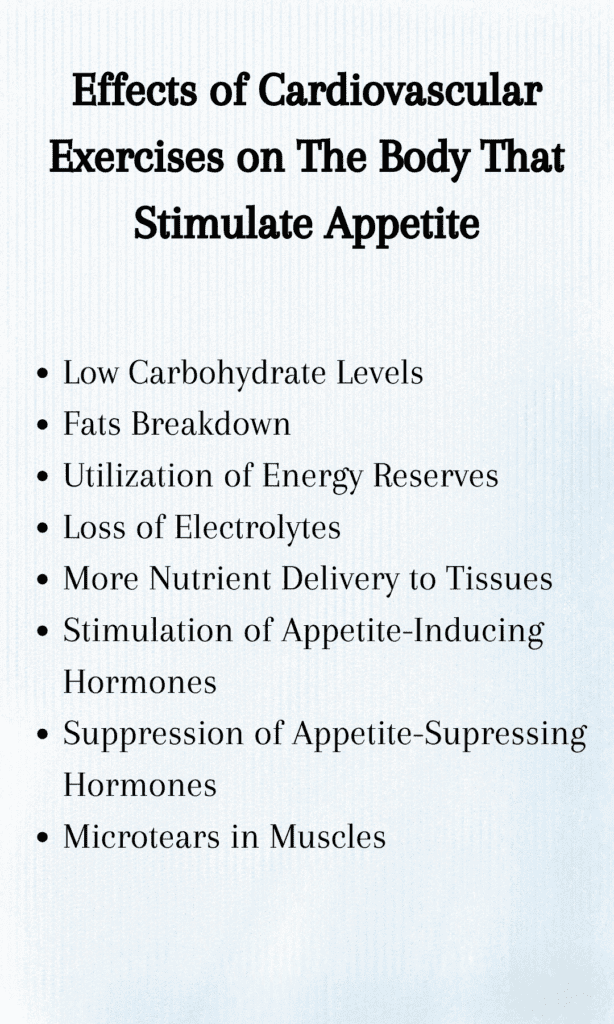How to stimulate appetite through cardiovascular exercises is not a greenhorn idea. Rather, it is one of the most prolific ways to stimulate appetite. Cardiovascular exercises or cardio workouts are two sides of a coin, with cardiovascular exercises being more of a biological term. As its name portrays, these exercises give the cardiovascular system a bit tough time. A tough time is a stair-climbing strategy for anything to become more productive. Similarly, how to stimulate appetite through cardiovascular exercises provides the knowledge to make the cardiovascular system more proactive.
The Cardiovascular Exercises And How They Affect Cardiovascular System
Cardiovascular exercises are usually mild aerobic exercises. The intensity of these exercises can be high but the mild ones are more effective in bringing appreciable changes. These exercises, being aerobic, consume and demand more oxygen. They affect the cardiovascular system as it is mainly responsible for delivering oxygen to all body parts. Apart from this, it would be easy understanding to understand how aerobic exercises shape the cardiovascular system. Lungs, heart, and blood vessels are the main frontiers of the cardiovascular system and these exercises keep this organ in touch. How to stimulate appetite through cardiovascular exercises is the next level of perception. Let’s see this relation with interesting ideas and a thorough understanding.
Explaining How to Stimulate Appetite Through Cardiovascular Exercises
The following 7 ways are the goldmine of information to comprehend the weightiness of cardiovascular exercises in optimizing appetite and satiety. Repetitive signals of appetite in short bursts are also unhealthy for the body as they add to the bulk of the fats. On a different note, appetite suppression is far more dangerous than repetitive signals of appetite. Appetite suppression, if persists for a long time, results in severe malnutrition and provides tenous conditions for the body to survive. More than one reason can result in desensitizing appetite stimulants. The reason can be psychological, environmental, or maybe disturbances in the body’s metabolism. But, most of the time, the reasons are psychological or behavioral. Well, the reasons behind appetite suppression are another cup of tea. Let’s discuss our topic: How to Stimulate Appetite Through Cardiovascular Exercises?
Boost in Metabolism
While doing cardiovascular exercises, the body needs an abundant oxygen supply. It is a general concept. But, how body utilize all the available oxygen supply to it? Why body needs oxygen while doing any muscular activity? Coming to the answer, the body does not directly provide oxygen to the muscles for their movement. On the contrary, the body has to produce chemical energy in the form of ATP. ATP is the energy format for the body to use. The body cannot directly use available energy in the vicinity for supporting metabolic reactions.
To process ATP production, the body needs oxygen. This is the reason we have to inhale more and more oxygen while exercising and still, we remain short of oxygen. The body produces ATP by the process of aerobic respiration in the mitochondria. Aerobic respiration needs oxygen to follow the metabolism of ATP synthesis. As this process takes place in mitochondria, its number and functional ability both have to be raised. So, the body works more and consumes more energy stores to sustain this high metabolic activity.
During exercise, increased metabolic activity upsets the body’s balance. Energy demand and energy production may not counterbalance each other. This results in a negative figure of energy balance. Moreover, when the body relies on reserve energy resources, exercises generate a vicinity or a lacking environment of these resources. When cardio exercises gain a gradient from light to intense levels, some stress hormones, such as cortisol or adrenaline also rise. These hormones assist the body become compatible with the exercise effects on the body.

In a nutshell, all such physiological changes jostle the body’s homeostasis. To restore homeostasis after cardiovascular exercises, the body boosts its metabolic activities. And high metabolism means the body needs more resources to counter the effects of exercise. It needs nutrients. This demand stimulates the appetite by activating the changes for raising appetite.
Body Reserves Go Lacking
During cardiovascular exercises, body reserves (prominently glycogen and fats) go lacking. It would not be possible that the oxygen we inhale during exercise would be sufficient for all energy production in the body. Additionally, during aerobic respiration, oxygen assists the process and is indeed important. However, oxygen does not act as a substrate to produce energy (in the form of ATP). Glucose is the most focal substrate for energy production. When we feed our body with carbohydrates, it breaks down the big molecules into smaller and simpler glucose molecules.
Still, the body does not store glucose in its active form. It converts glucose into glycogen (another form of glucose that the body synthesizes for storage). Glycogen then serves as the energy source for ATP production. Therefore, glycogen stores are lacking during physical activities as the body uses them at a high rate. When the duration of exercise is noteworthy, the body may use maximum glycogen stores. In these conditions, fats serve as the secondary energy source. Fats breakdown produces a good amount of energy to satisfy the body’s needs. In this way, the body also gets relief from excess fats.
Almost the same process happens in diabetes type 2 disease when cells cannot use glucose and start using fats to produce the necessary energy. In this way, most patients of diabetes type 2 disease are thin in fats. The point of the theory, the body depletes energy reserves and after exercise, it needs to restock them back. Now, for restocking, eating carbs and healthy fats is vital for the body. So, how to stimulate appetite through cardiovascular exercises becomes self-evident.
Thermogenesis Effect on Appetite Stimulation
As the body produces ATP, it also produces heat as a side-product. All metabolic processes produce energy as a side product. So, during exercise, body temperature also rises with the increase in the production of ATP. This rise in body temperature makes significant changes that also lead to appetite stimulation. Here’s the detail, more metabolism generates more heat. More heat, in turn, boosts the metabolism again. This cycle tends the body’s fats to break down with more speed.
High body temperature spurs the body processes to occur at a more steady rate. This cyclic activity only results in the depletion of fats, glucose, and nutrients from the body, as the body uses them in titanic volume. Furthermore, high body temperature enhances the loss of fluids and electrolytes through sweating or perspiration. Loss of fluids may not be the stimulant for hunger but thirst. Electrolyte loss is an acceptable stimulant for appetite. Electrolytes operate momentous functions such as nerve impulse transmission, muscle contractions, etc. So, a rise in body temperature is an explanation in itself of how to stimulate appetite through cardiovascular exercises.
Bye Bye Hypoperfusion
Hypoperfusion results when the vascular system is not able to nourish all body parts. Perfusion relates to the perfusion of blood into the body cells, hypoperfusion results when there is insufficient blood flow. It results in severe dehydration when blood volume gets too low. It also occurs due to vascular obstruction. But, cardiovascular exercises aim at blood circulation. When the body generates heat in the realm of high metabolism, it also poses an effect on vasodilation. Concerning vasodilation, blood flow heightens and nourishes every body cell.
The influence of cardiovascular exercises on the blood-vascular system is noticeable. With proficient blood circulation, nutrients are now more in circulation and more prone to absorption. To renew nutrients present in the blood, the body stimulates appetite to get in touch with new nutrients.
Secretion of Hunger Hormones
Use-up of energy reserves turns on energy demand mechanisms. Secretion of hunger hormones is one of the prominent grounds for appetite stimulation. Ghrelin is the most dedicated hormone in this framework. Mucosal cells of the stomach produce ghrelin, which sparks physiological changes to boost hunger. Keeping the top priority, ghrelin sends signals to the hypothalamus region which has the role of hunger arousal. This region secretes a neuropeptide Y into the bloodstream. Ghrelin and neuropeptide Y, together stimulate appetite. Let’s see how.
They boost appetite by more than one adaptation. They help in the emptying of the gastrointestinal tract and induce hunger movements in the gut, triggering the signal for food. Also, they activate reward-processing regions in the brain. This, in turn, brings about the arousal of serotonin, and dopamine that further stimulate the appetite for good food. Ghrelin also affects Leptin, another hormone that fatty tissues produce. Leptin works oppositely to Ghrelin. Ghrelin diminishes the leptin levels to alleviate the signs of satiety.
Mood-Boosting Effects of Exercise Heightens Appetite
Exercises relate hormonal regulation side by side. With the increase in hunger hormones, cardiovascular exercises also cause an elevation in mood-boosting hormones such as serotonin, dopamine, endorphins, etc. It is a general perspective that an increase in appetite has a behavioral relation with a good mood. Endorphins and dopamine relax the body and urge it to eat something whose aroma satisfies the appetite receptors. How food aromas act as a stimulus for increasing appetite would be my topic for another blog.
Exercise impacts mental health by triggering the release of stress and relaxing hormones at the same time. Exercise, at the initial stages, seems a kind of stress to the body. In response to this, the body activates the sympathetic nervous system to combat upregulating situations. But, after a time, when exercise prolongs, the body promotes the release of endorphins and other relaxing hormones. This step is to counterbalance the effects of the sympathetic nervous system. In the presence of mood-enriching chemicals, we feel more attracted to appetizing odors.

How to stimulate appetite regarding post-exercise effects
Post-exercise effects indulge mechanisms to restore the body’s balance, repair muscle tissues, balance the energy equilibrium, and recover the body’s internal energy resources. Most of these effects are discussed in the first point about the high rate of the body’s metabolism. It can be known to all that metabolic rate rises during the course of exercise. However, the metabolic rate continues at that pace even after the exercise. This results in the recognition of post-exercise effects, also known as Excess Post-Exercise Oxygen Consumption (EPOC). EPOC manifests to recover the body conditions to the original state. It can’t be that perfect like the elastic law.
Exercise leave impacts on the body. But these impacts are healthy, not harmful. Tough aerobic exercises cause micro tears in the muscle fibers. Moreover, increased sweating results in fluid and electrolyte upsetting. The body’s metabolic rate still produces energy after exercise to stabilize it. Muscle fibers gain microtears and they need nutrients. So, all these processes point towards a single necessary body setting and that is the stimulation of appetite receptors. Eating healthy food is one way to provide nutrients, oxygen, and electrolytes to the body. So, the body starts to work on this.
At last
At last, why the body needs food becomes self-evident. And why exercises urge to eat more also become understood. So, how to stimulate appetite through cardiovascular exercises is a natural way of eating with joy. Besides, after a successful period of physical activity, the brain takes it as a form of task, and it activates reward-dealing mechanisms. Such mechanisms urge the body to obtain favorable food as a reward.




